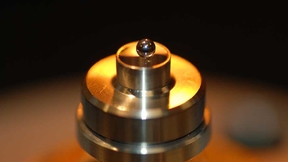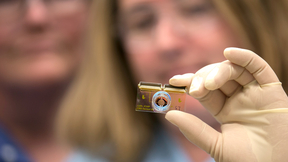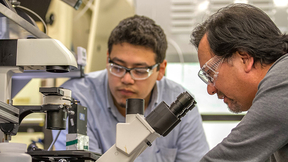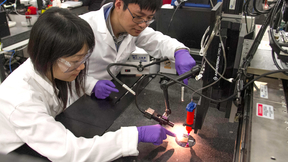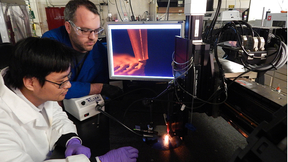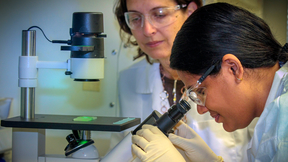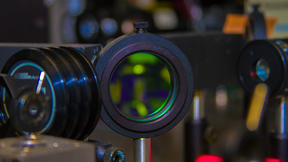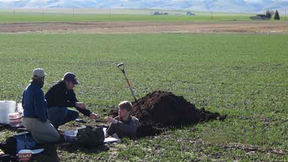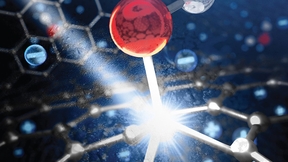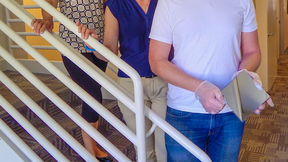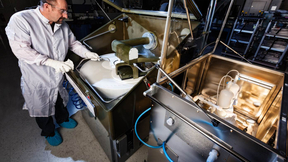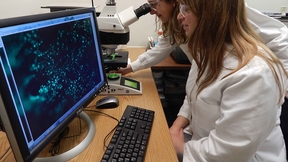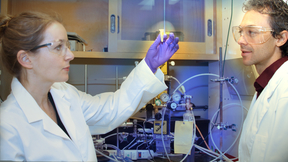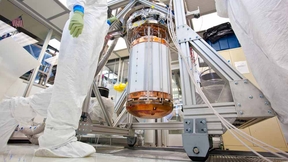Back
Particulate soil carbon may be more vulnerable to microbial decomposition under warmer temperatures associated with climate change. Soil organic matter contains more carbon than plants and the atmosphere combined. Soil is increasingly considered for its potential role in climate mitigation due to its ability to sequester more carbon, but it also is critical to understand…
Lawrence Livermore National Laboratory researchers have garnered three awards among the top 100 industrial inventions worldwide for 2016. The trade journal R&D Magazine announced the winners of its annual awards, sometimes called the "Oscars of invention," Thursday at the Gaylord Convention Center in Washington, D.C. With this year’s results, the Laboratory has now…
Development of new prescription drugs and antidotes to toxins currently relies extensively on animal testing in the early stages of development, which is not only expensive and time consuming, it can give scientists inaccurate data about how humans will respond to such agents. But what if researchers could predict the impacts of potentially harmful chemicals, viruses or…
New identification of a gene involved in the fracture healing process could lead to the development of new therapeutic treatments for difficult-to-heal injuries.Fracture healing involves communication between bone, muscle, vasculature and the thin membrane covering the outer surface of bones (periosteum) during the fracture repair. The periosteum contains stem cells that…
Installation of a highly advanced 3D printer for electronics at Lawrence Livermore National Laboratory has opened the door for creating miniature circuits on surfaces and substances that could never be used before.The Optomec Aerosol Jet 500 system, which became operational in January, is capable of printing circuits with a broad range of nanomaterials, allowing engineers…
For the first time ever, scientists at Lawrence Livermore National Laboratory and UC Santa Cruz have successfully 3D-printed supercapacitors using an ultra-lightweight graphene aerogel, opening the door to novel, unconstrained designs of highly efficient energy storage systems for smartphones, wearables, implantable devices, electric cars and wireless sensors.Using a 3D…
Reactive composite materials are everywhere, from the life-saving air bags in your car to the dazzling pyrotechnics in Fourth of July fireworks. But one of the main drawbacks to using these materials has been the unpredictability of their reactions.Historically, the way to alter the performance in reactive materials (i.e. thermites) has been to either change the…
The cardiovascular system is a complex web of tens of thousands of miles of arteries, capillaries and veins, branching throughout the body like tributaries of a great river. And now, researchers at Lawrence Livermore National Laboratory are recapitulating this intricate network using an emerging technology: 3D bioprinting."It’s going to change the way we do biology," said…
Scientists from Lawrence Livermore National Laboratory, in collaboration with researchers from University of California campuses at Merced and Davis, have found that a specific secreted protein inhibits prostate cancer metastasis to bone.Their research appears in recent editions of the journals, PLOS ONE and Microarrays.Prostate cancer is the most frequently diagnosed…
Lawrence Livermore National Laboratory researchers are the recipients of three awards among the top 100 industrial inventions worldwide for 2014.The trade journal R&D Magazine announced the winners of its annual awards, sometimes called the "Oscars of invention," Friday in Las Vegas. With this year's results, the Laboratory has now captured a total of 155 R&D…
Laser wakefield acceleration, a process where electron acceleration is driven by high-powered lasers, is well-known for being able to produce high-energy beams of electrons in tabletop-scale distances. However, in recent experiments, a team of scientists from Lawrence Livermore National Laboratory (LLNL) and the University of California, Los Angeles (UCLA) revealed new,…
By tightly integrating experimental and theoretical techniques, a Lawrence Livermore National Laboratory team has provided fundamentally new insights into the specific factors that determine the absorption characteristics of copper complexes. The results demonstrate that conventional interpretations based on "ligand field theory" -- a staple concept in inorganic chemistry …
Soil organic matter, long thought to be a semi-permanent storehouse for ancient carbon, may be much more vulnerable to climate change than previously thought.Plants direct between 40 percent and 60 percent of photosynthetically fixed carbon to their roots and much of this carbon is secreted and then taken up by root-associated soil microorganisms. Elevated carbon dioxide …
Lawrence Livermore researchers have identified electrical charge-induced changes in the structure and bonding of graphitic carbon electrodes that may one day affect the way energy is stored.The research could lead to an improvement in the capacity and efficiency of electrical energy storage systems, such as batteries and supercapacitors, needed to meet the burgeoning…
Multilayer-coated mirrors, if used as focusing optics in the soft gamma-ray photon energy range, can enable and advance a range of scientific and technological applications that would benefit from the large improvements in sensitivity and resolution that true imaging provides. In a paper published in a recent online edition of Optics Express, LLNL postdoc Nicolai Brejnholt…
Lawrence Livermore National Laboratory researchers are the recipients of four awards among the top 100 industrial inventions worldwide for 2013.The four technologies honored were developed by three teams of LLNL researchers who worked with industrial collaborators, and also by a multidisciplinary Lab team of scientists and engineers.The trade journal R&D Magazine…
LIVERMORE, Calif. - Imagine a material with the same weight and density as aerogel -- a material so light it's called 'frozen smoke' -- but with 10,000 times more stiffness. This material could have a profound impact on the aerospace and automotive industries as well as other applications where lightweight, high-stiffness and high-strength materials are needed.Lawrence…
Lawrence Livermore scientists have found that carbon nanotubes can help with tissue healing and repair.The team, which includes scientists from The Feinstein Institute for Medical Research, UC Davis and UC Merced, found that there is long-term biocompatibility of single wall carbon nanotubes (SWNTs) when used for tissue engineering and articular cartilage.Carbon nanotubes…
In an effort to put to good use natural gas (methane) that might otherwise become pollution, Lawrence Livermore National Laboratory is collaborating with start-up company Calysta Energy on a new technology to convert natural gas to liquid fuel.The process involves taking natural gas from oil and gas operations, and converting it to methanol that can be used as a fuel or…
LEAD, S.D. - After its first run of more than three months, operating a mile underground in the Black Hills of South Dakota, a new experiment named LUX has proven itself the most sensitive dark matter detector in the world."LUX is blazing the path to illuminate the nature of dark matter," says Brown University physicist Rick Gaitskell, co-spokesperson for LUX with…


